Campaign debt
After an election, some House and Senate campaigns have outstanding debts, including money owed to campaign vendors. Campaigns must report debts and obligations continuously until repaid.
Debt reporting thresholds
- A debt of $500 or less is reportable once it has been outstanding 60 days from the date incurred (the date of the transaction, not the date the bill is received). The debt is disclosed on the next regularly scheduled report.
- A debt exceeding $500 must be reported in the report covering the date on which the debt was incurred.
Calculating debt
Calculating a campaign’s “net debts outstanding” is a two-step process. First, a campaign tallies up all of its unpaid debts as of the election date. Unpaid debts include all outstanding debts and obligations, and the estimated cost of raising funds to pay off the debts. If a campaign is terminating, estimated winding down costs are included as unpaid debts.
Second, a campaign subtracts its cash-on-hand and any amounts owed to the campaign or candidate from its unpaid debts. The resulting amount is a campaign’s net debts outstanding. If a candidate has loaned more than $250,000 per election to a campaign, then any amount over $250,000 per election is not included in net debts outstanding (see “Repaying Candidate Loans” below for more information).
The campaign continually recalculates its total net debts outstanding as additional funds are received for, or spent on, the election for which the debt remains.
Raising contributions to retire debt
When raising contributions to retire debts after the election is over, a campaign must remember three general rules:
- Contributions towards debt retirement are subject to the limits and prohibitions applying to the election for which the funds are raised and must be combined with the contributor’s prior contributions for that election;
- Contributions made after an election to retire debts must, in most cases, be designated for that election by the contributor; and
- Contributions designated for, but made after, a particular election may not exceed the campaign’s net debts outstanding.
Reporting tip:
Report debt retirement contributions on Line 11 of Form 3 and itemize, if necessary, on Schedule A with a note that the contribution is for debt retirement. See Example A below.
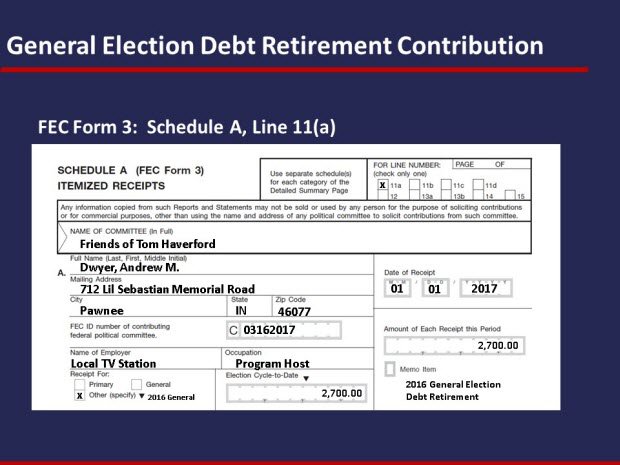
Example A: FEC Form 3: Schedule A, Line 11(a). General election debt retirement contribution
Selling campaign assets to retire debt
Under certain conditions, committees may sell certain assets (such as campaign office equipment and mailing lists) at the “usual and normal charge” to raise funds to retire debts without the sale resulting in a contribution from the purchaser. For more information, see Advisory Opinions 2003-19, 2002-14, and 1986-14.
Reporting tip:
Disclose the sale of committee goods or services on Line 15 of Form 3 and itemize on Schedule A for that line if aggregates over $200 for the election cycle. See Example B below.
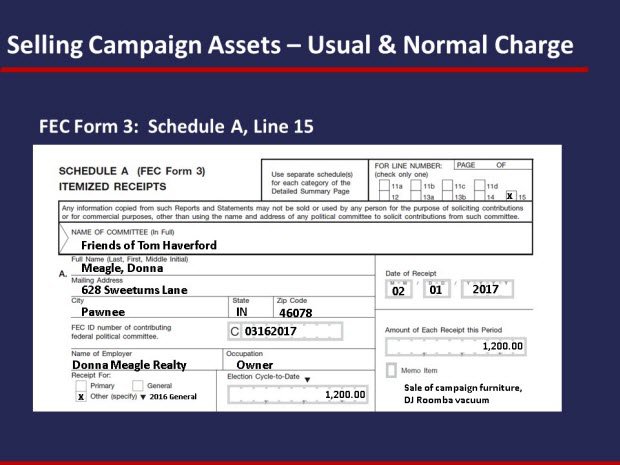
Example B: FEC Form 3, Schedule A, Line 15, Selling Campaign Assets - Usual and Normal Charge
Reporting campaign debt
A debt of $500 or less is reportable on the next regularly scheduled report once it has been outstanding for 60 days from the date incurred (the date of the transaction, not the date the bill is received). Report debts on Schedule D until they are fully repaid. Debts exceeding $500 are disclosed in the report covering the date on which the debt was incurred. See Example C below.
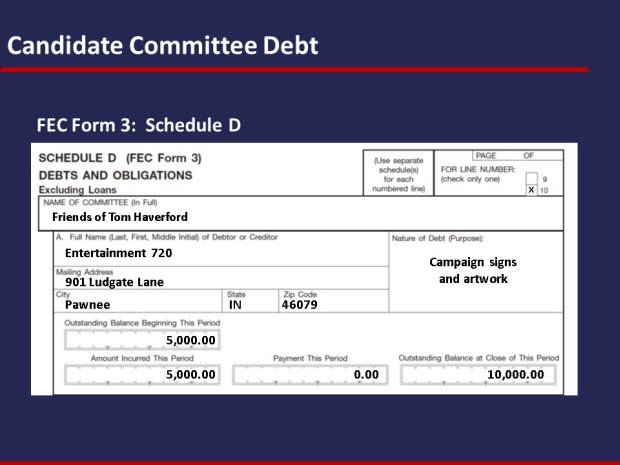
Example C: FEC Form 3, Schedule D: Candidate Committee Debt
If the exact amount of a debt is not yet known, the treasurer may report an estimated amount, noting that the figure is an estimate. Once the committee knows the actual amount, the treasurer must either amend the earlier report (and all subsequent reports) to indicate the correct amount, or include the correct figure with an explanation of the change in the campaign’s next report.
Disputed debts
A disputed debt occurs when a creditor and committee disagree on the existence or amount of a debt. State laws govern whether an alleged debt exists, what the amount is, and who is responsible for paying it. If a disputed debt exists, disclose the amount the committee admits it owes, the amount the creditor claims is owed, and any amounts the committee has paid the creditor. The committee may use memo text to provide additional explanation.
The disclosure of a disputed debt is not an admission of liability or a waiver of any claims against the creditor. Once a dispute is resolved, report the correct amount on the next report, with an explanation of its resolution.
Unpayable debts
A committee with an unpayable debt, such as a debt owed to a defunct or unresponsive entity, should call its Reports Analysis Division (RAD) analyst for assistance. RAD typically advises committees to file a statement that includes a request to discontinue reporting the debt, an explanation of why the debt is unpayable, and what efforts the committee has made to contact the vendor. Committees must continue to report the debt until they verify with RAD that a debt no longer needs to be reported.
Candidate loans
Candidates may lend money from their personal funds to their campaign committees and may charge a commercially-reasonable interest rate.
Reporting tip:
Report the receipt of the loan from the candidate on Schedule A, Line 13(a) of Form 3 regardless of the amount of the loan. Also report the loan on Schedule C until it is fully repaid. Include all loan terms on Schedule C. If there is no due date or interest rate, enter “none” or “n/a,” but do not leave these fields blank. Include the term “personal funds” on either Schedule A or C. See Example D below.
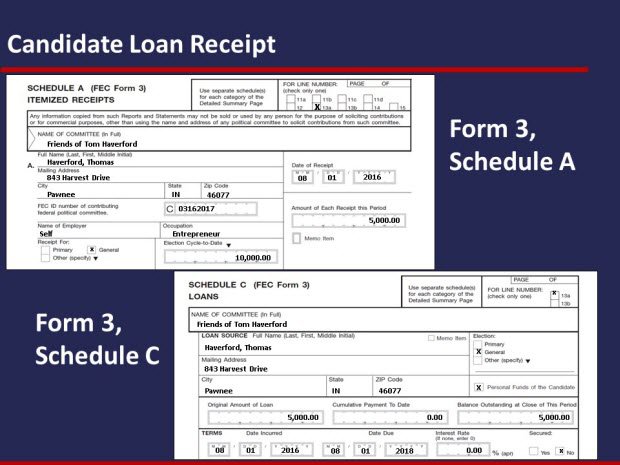
Example D: FEC Form 3, Schedule A, Line 13(a) and Schedule C: Candidate Loan Receipt
Repaying candidate loans
If the candidate makes loans to the campaign that exceed $250,000 per election, the following rules apply:
- The committee may use contributions to repay the candidate for the entire amount of the loan(s) only if those contributions were made on or before election day; and
- The committee may use contributions to repay the candidate up to $250,000 from contributions made after election day.
If the committee uses the amount of cash-on-hand as of election day to repay the candidate for loans greater than $250,000, it must do so within 20 days of the election. The committee must treat the portion of candidate loans that exceed $250,000, minus the amount of cash-on-hand as of the day after the election, as a contribution by the candidate.
Reporting tip:
Report loan payments on Schedule B, Line 19(a) of Form 3 and on Schedule C. See Example E.
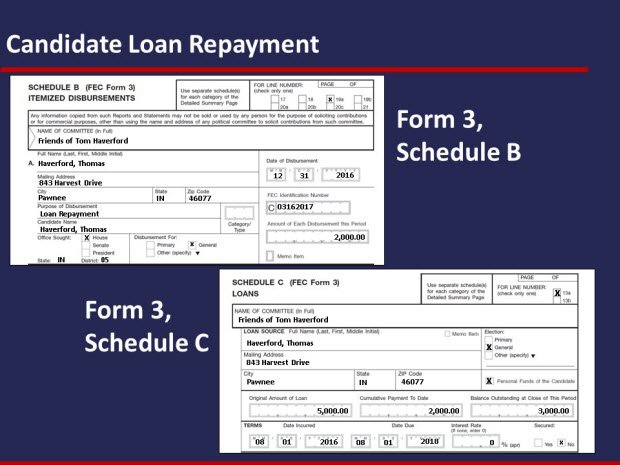
Example E: FEC Form 3, Schedule B, Line 19(a) and Schedule C: Candidate Loan Repayment
Report interest payments as operating expenditures. Itemize on Schedule B, Line 17 of Form 3, once payments exceed $200 in the election cycle. See Example F.
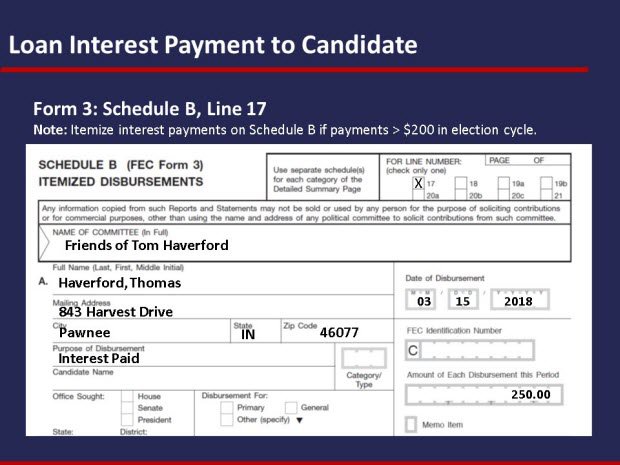
Example F: FEC Form 3, Schedule B, Line 17: Loan Interest Payment to Candidate
Candidate loan forgiveness
If the candidate forgives a loan of personal funds, the candidate files a signed statement to the FEC stating that she or he forgives the loan. (Senate committees send this statement to the Secretary of the Senate.)
Other candidate loans
If the candidate obtained a bank loan or other line of credit and loaned that money to the campaign, the committee must follow special reporting instructions. List the candidate as the loan source and identify the type of loan. A candidate loan is reported regardless of its amount. Report loans continuously on Schedule C until they are fully repaid. Committees disclose all the loan terms between the candidate and the committee on Schedule C. If there is no due date or interest rate, enter “none” or “n/a”, but do not leave these fields blank. See Example G.
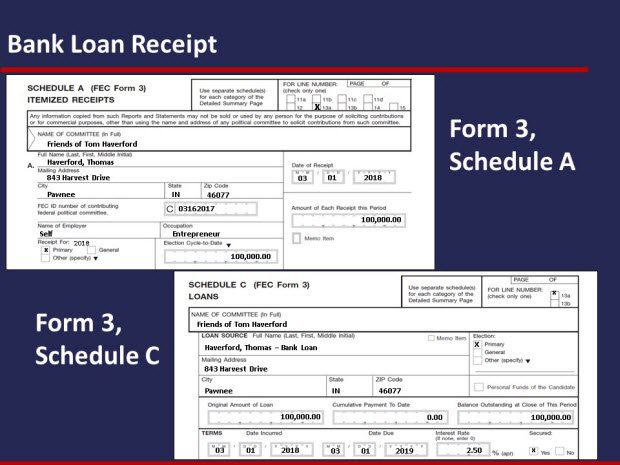
Example G: FEC Form 3, Schedule A, Line 13 and Schedule C: Bank Loan Receipt
The committee also must file a Schedule C-1 to disclose the terms between the candidate and the bank. See Example H.
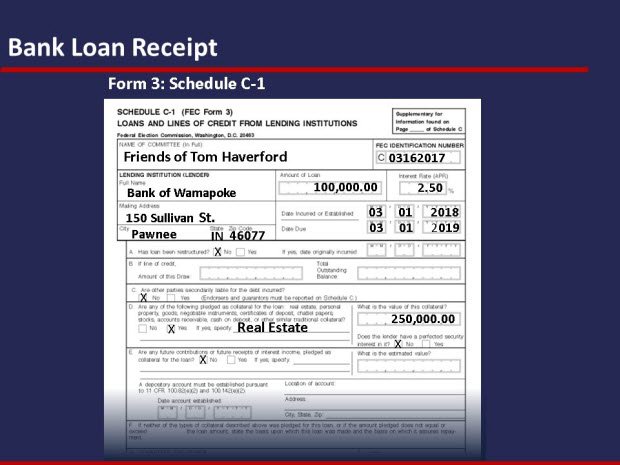
Example H: FEC Form 3, Schedule C-1: Bank Loan Receipt
The committee can either repay the candidate or the bank for this type of loan. When repayments are made to the candidate, the committee is not required to report the repayments made by the candidate to the lending institution. Report interest payments as operating expenditures.
Reporting tips:
For bank loans, report repayments on Schedule B, Line 19(b) of Form 3. Report interest payments on Line 17 of Form 3 once payments exceed $200 in the election cycle. See Examples I and J.
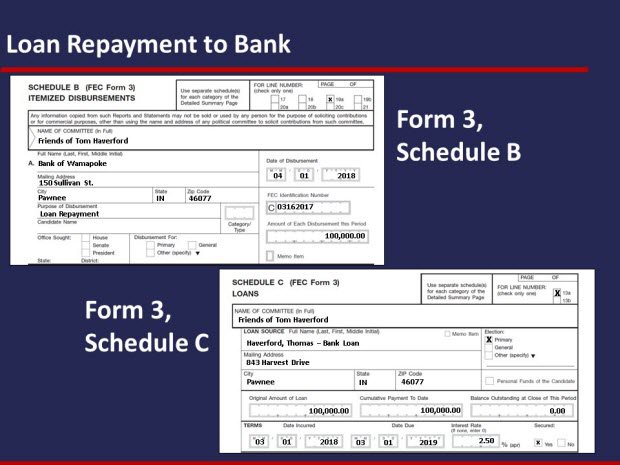
Example I: FEC Form 3 Schedule B, Line 19(b) and Schedule C: Loan Repayment to Bank
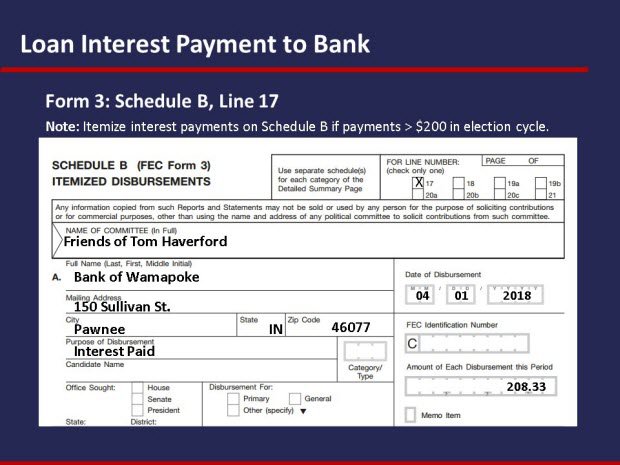
Example J: FEC Form 3, Schedule B, Line 17: Loan Interest Payment to Bank